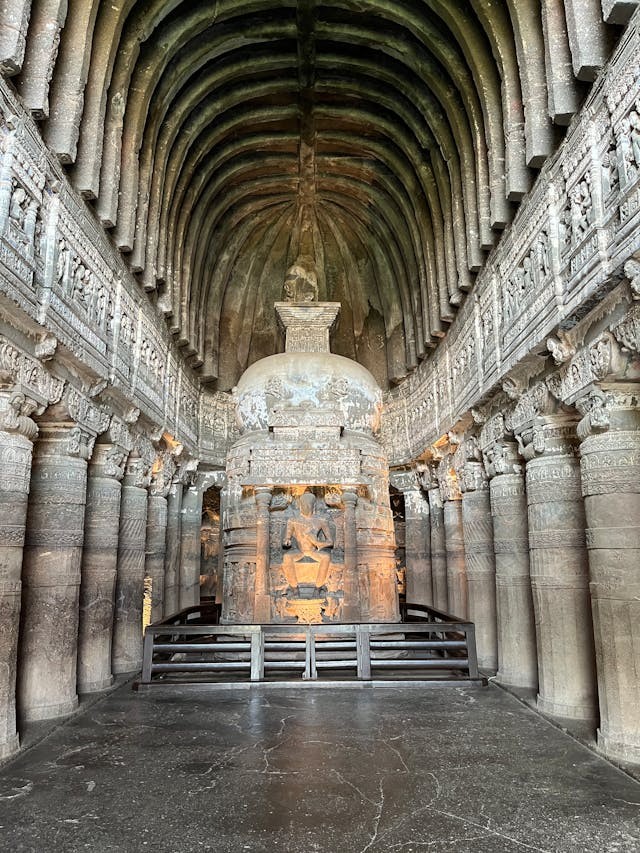When you think of Indian architecture, the Taj Mahal often comes to mind first. Its marble beauty is known across the world, but did you know that India is home to many other spectacular monuments that were built long before the Taj was completed in 1653? If you are planning a trip across India in the remaining months of 2025, you should definitely explore some of these incredible architectural wonders. They tell stories of dynasties, devotion, and unmatched craftsmanship that shaped the identity of India.
Ajanta & Ellora Caves: Masterpieces of Rock-Cut Art
One of the finest places to start is the Ajanta and Ellora Caves in Maharashtra. The Ajanta Caves, dating back as early as the 2nd century BCE, are filled with rock cut Buddhist monasteries and prayer halls. The murals and sculptures here are some of the best surviving examples of ancient Indian art. Not far from Ajanta, the Ellora Caves stand out with the jaw dropping Kailasa Temple, carved entirely out of a single rock in the 8th century. When you see this massive temple, it is hard to believe that such engineering was even possible without modern machines. Together, Ajanta and Ellora give you a glimpse of India’s spiritual and artistic brilliance centuries before the Taj Mahal.
Khajuraho & Rani-ki-Vav: Sculptural Wonders & Stepwell Grace
Traveling east, Khajuraho in Madhya Pradesh is another jewel. Built between 950 and 1050 CE by the Chandela dynasty, the temples here are famous for their intricate stone carvings that depict gods, goddesses, and even scenes from everyday life. The level of detail makes you pause and admire how every sculpture seems alive. Around the same period in Gujarat, the majestic Rani ki Vav stepwell was built. This 11th century masterpiece was designed not just as a water reservoir but also as a subterranean temple with seven levels of beautifully carved panels. Walking down its steps feels like stepping into history where art and utility blended seamlessly.
Konark Sun Temple: The Chariot of the Sun God
If you are drawn towards coastal India, the Konark Sun Temple in Odisha is an absolute must see. Built around 1250 CE, the temple was shaped like a giant stone chariot dedicated to Surya, the Sun God. The wheels and horses carved out of stone are so detailed that they almost look ready to move. Although much of the temple is in ruins today, the grandeur is still powerful and unforgettable. Standing in front of Konark, you can almost imagine how it would have looked when sunlight illuminated every corner of its walls.
Hampi’s Lotus Mahal and Stone Chariot: Vijayanagara Marvels
In South India, Hampi offers another treasure trove of architecture. The Lotus Mahal, with its delicate Indo Islamic design, feels different from the towering temples you usually see in India. It was once a royal retreat and still carries an aura of elegance. Close by, the Vijaya Vittala Temple has the famous stone chariot and the legendary musical pillars that produce different notes when tapped. Though protected now to prevent damage, the idea that stone could make music captures the creativity of Vijayanagara craftsmen.
Humayun’s Tomb: The Mughal Garden-Tomb That Inspired the Taj
Before the Taj Mahal, the Mughals had already experimented with grand garden tombs. The best example is Humayun’s Tomb in Delhi, completed in 1572. This monument was the first garden tomb in India and introduced the Persian style charbagh layout that later inspired Shah Jahan when he built the Taj. When you walk through Humayun’s Tomb, you will immediately notice the symmetry and elegance that would eventually reach its peak in Agra.
Why Visit These Architectural Wonders Before 2025 Ends?
Visiting these architectural wonders is not just about seeing old buildings. It is about experiencing the ambition and artistry of past civilizations. The Ajanta murals tell you about Buddhist monks who turned cliffs into canvases. The stepwells like Rani ki Vav reveal how people solved water scarcity while celebrating art. The temples of Khajuraho and Hampi remind you of a time when stone was used to capture both faith and beauty. Humayun’s Tomb shows how ideas travel across dynasties and evolve into iconic landmarks.
If you are planning your travels for the rest of 2025, these monuments are timeless choices. They are evergreen destinations where you can admire ancient engineering, capture beautiful photographs, and connect with India’s layered history. Whether you choose to walk through the caves of Ajanta, climb the steps of Rani ki Vav, or watch the sunrise at Konark, every experience will give you a deeper understanding of India beyond the Taj Mahal. And that is what makes these places truly unforgettable.


Loved this! History, art, and engineering at their finest, beyond the usual tourist trails.